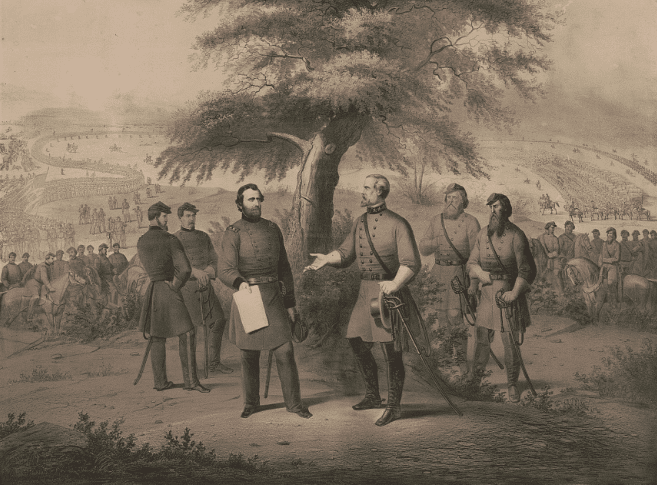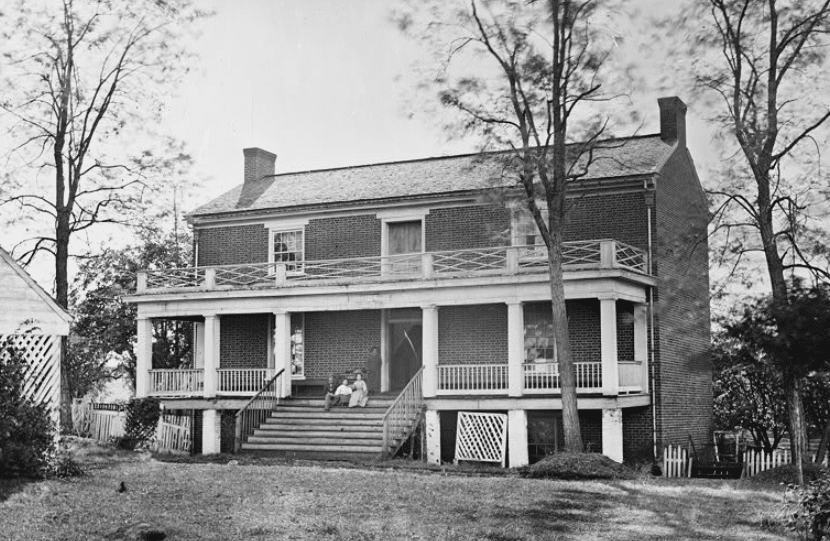Remembering Appomattox: The Civil War’s End, 160 Years Later
 10
10Apr

“I need not tell the survivors of so many hard fought battles, who have remained steadfast to the last, that I have consented to the result from no distrust of them.”
Robert E Lee, 10 April 1865
These were the words of Gen. Robert E Lee in his General Order No. 9, written after his surrender to Lt. Gen Ulysses S Grant at Appomattox Court House in Virginia. This was also known as his Farewell Address and was written the next day after the surrender. [1] These are the words that many unionists cheered for, while many confederates felt defeated. Regardless of personal feelings, the war was finally coming to an end.
April 9, 1865 – The Day the Civil War Came to an End
Although the official end of the war was declared in August 1866, the surrender of General Robert E Lee to Ulysses S Grant at Appomattox Court House, Virginia, on April 9, 1865, marked the beginning of the end of the American Civil War. [2] This day shaped the lives of our ancestors and is a pivotal event in American, and world, history. Whether our ancestors wore union blue, confederate grey, or were among the enslaved individuals who witnessed their freedom from bondage, April 9, 1865, will forever be remembered as a crucial and universally changing event for millions of lives.
The War’s Final Days
After the fall of Richmond, Virginia, on April 2, Confederate President Jefferson Davis and his army fled, and Confederate forces began collapsing. Gen. Robert E Lee's surrender to Union Gen. Ulysses S Grant marked a turning point, as Lee commanded the Confederacy’s most respected army, the Army of Northern Virginia. [3]
Lee’s final campaign began with an unsuccessful attack at Fort Stedman on March 25. Following defeats at Richmond and Petersburg, Lee's army attempted to retreat but was stopped by Union forces. After a failed attempt at defeating Grant at Appomattox on April 9, Lee requested a meeting with Grant. They met at Appomattox Court House (the name of the village, not just a courthouse), where Lee surrendered his army. This surrender set the precedent for other surrenders, eventually leading to the official end in 1866. [3]
The Surrender
On the morning of April 9, 1865, Gen. Lee hoped to bust through the Union lines and continue his trajectory south. However, he was roadblocked. As a last-ditch effort for survival, Lee requested a meeting with Grant, and eventually the two met at the McLean House. [4]

Grant offered his conditions: Lee surrenders to Grant, and Grant will parole and not prosecute Confederate soldiers. Lee had no choice but to accept. After the agreement was formally documented, Grant issued his parole passes to almost 30,000 Confederate soldiers. [4]
Days later, President Abraham Lincoln was shot by Confederate sympathizer John Wilkes Booth at Ford’s Theatre and died the following morning. This set the tone for the ending of the war, as the atmosphere of the United States weighed heavier than ever before.

The Aftermath
After the surrender, battles continued until the official end of the war on August 20, 1866, when President Johnson issued a proclamation announcing the ending of the war. [3] The Confederate soldiers returned home, facing an uncertain future as the outcome of the war would be in the hands of the Union army. Following the end of the war, many Americans, from both sides of the fight, were left in shambles as they began to recover from the financial, emotional, and physical effects of the war. Following this, the Reconstruction era would begin to rebuild the United States of America and transition the formerly enslaved into a new world, free from bondage.
Researching Your Civil War-Era Ancestors
Use this day in commemoration to think about the lives of your ancestors who were alive at that time. Ask yourself some thought-provoking questions to get ideas about what you want to learn about your ancestor.
- Did my ancestor serve in the war? What side did they serve on?
- How were they affected by emancipation or the destruction of their home or community?
- What happened to them after the war? Did they move, remarry, or disappear from records?
Researching Civil War-era ancestors can be a tumultuous but gratifying experience. Let’s look at some of the most common and less common resources to learn more about our ancestors.
Military Service Records
- Union & Confederate Service Records – Service records contain valuable information about your ancestors' service, like age, place of birth, regiment information, and death information if they died during the war. Muster roll cards can tell you where your ancestor was during a specific time. Images of Confederate service records are accessible online, while most Union service records will have to be requested through the National Archives. Ancestry has multiple collections that provide information about Union soldiers. The most valuable collections are the S., Civil War Soldiers, 1861-1865 collection and the U.S., Civil War Soldier Records and Profiles, 1861-1865. Another great resource is the Soldiers and Sailors Database (note: the database is no longer maintained and updated but is accessible).
- Pension Records – One of the most valuable resources genealogists can use for military ancestors is pension records. These records can contain a goldmine of information about the person who served, their widow, and their children. Southern pension files (administered by the state where the confederate veteran lived) are primarily accessible online. However, union pension files can only be accessed through the National Archives (either in person or by ordering online). There are indexes of the pensions online at most major genealogy websites. Once you have the information from the index, you can request copies of the entire pension file.
Freedman’s Bureau Records
- Created by Congress in 1865, the Freedman’s Bureau was created to help transition the formerly enslaved to freedom and citizenship. [5] This also created millions of records that genealogists can use to help reconstruct their families. Not only do the formerly enslaved appear in these records, but there are also records of white men who suffered financial losses during the war. These records are free to view at Ancestry. The Freedmen’s Bureau Transcription Project is an ongoing transcription project by the National Museum of African American History and Culture. Once completed, it will allow full-text searches and access to over 1.7 million digital images of original records.
1860 & 1870 Census
- An interesting exercise a genealogist can do to see how the Civil War affected our ancestors’ finances is to compare the reported value of their real and personal estates in 1860 and 1870 using census records. If your ancestors had a significant loss, especially if they were enslavers, it might be evident when comparing their wealth before and after the war. For example, in 1860, Lieutenant General Wade Hampton (Confederate) had a real estate value of $25,000 and a personal estate value of $45,000. [6] In 1870, he had $50,000 worth of real estate, but only $1,200 worth of personal estate. [7] This was because of the emancipation of his enslaved people after the war, which had been counted as his personal property. Even if you have northern ancestors, they were likely financially affected by the war, so be sure to check for them, too.
Southern Claims Commission
- If you have southern roots, your ancestor may have filed a claim with the Southern Claims Commission. Created by an Act of Congress in 1871, it intended to allow Southern Unionists to claim compensation for supplies confiscated or used by the U.S. Army during the Civil War. [8]
Telling Their Stories
Even if your ancestor didn’t serve in the war, their life and the lives of their families were affected in some way. Look at your ancestor's siblings and see if any of them served. Think about the women who cared for the farms and the children while their husbands were at war.
You can share your ancestor's stories in many ways once you learn more about them. Genealogists sometimes run into the issue of finding ways to get their family interested in family history. Think about some of these ideas about how we can get our family interested in our ancestors' stories and at the same time honor them.
- Anniversary Posts—Posting to social media on an anniversary, such as birthdays, deaths, marriages, or holidays, can give our family bite-sized pieces of family history so that they are not overwhelmed. Consider posting a picture of your ancestor (or gravestone or a record) or biography of your Civil War ancestor on days like Veterans Day or the anniversary of the war's ending.
- Famous Relatives at FamilySearch – A cool feature that is offered at FamilySearch is the ability to see if you are related to someone famous. All it requires is a (free) account and a compiled family tree. You do have to verify the information connecting you to the famous person, but it’s still something that can create inspiration among your family members. If you discover you’re related to a famous Civil War-era leader, you can make a post, and it is guaranteed to spark interest.
- In-Home Activities – FamilySearch offers some great ideas for incorporating family history in the lives of your family members. The Family Trivia Game can be a fun and thought-provoking game for your family. You could spend some time sharing family history facts and stories, and then incorporate a trivia game into it.

Final Thoughts
Whether they fought in the battlefields or not, if you had ancestors living in the United States during or shortly after the Civil War, they were affected by the war and played a crucial part in American history. We can commemorate days like the anniversary of the end of the Civil War by remembering our ancestors and sharing their stories with our families and the world.
If you need help finding the records of your Civil War ancestors, Price Genealogy can help!
Tyler
Photos
1 - The surrender of General Lee. And his entire army to Lieut General Grant, April 9th. Appomattox United States Virginia, 1865. [Phila.: Pubd. by John Smith 756 So. 4th St. Phila., ?] Photograph. https://www.loc.gov/item/2015647830/.
2- O'Sullivan, Timothy H, photographer. McLean's House, Appomattox, Va. Scene of Lee's surrender. Virginia Appomattox Court House United States, 1865. [Photographed, Printed Later] Photograph. https://www.loc.gov/item/2014646187/.
3- Ford's Theatre, scene of the assassination. Washington D.C, 1865. Photograph. https://www.loc.gov/item/2009633713/.
4- Screenshot taken by author.
Resources
Civil War Soldiers, 1861-1865 database at Ancestry – https://www.ancestry.com/search/collections/1138/
Civil War Soldier Records and Profiles, 1861-1865 database at Ancestry – https://www.ancestry.com/search/collections/1555
Soldiers and Sailors Database – https://www.nps.gov/civilwar/soldiers-and-sailors-database.html
Confederate Pension Records at FamilySearch – https://www.familysearch.org/en/wiki/Confederate_Pension_Records
Civil War Pension Index: General Index to Pension Files at Ancestry – https://www.ancestry.com/search/collections/4654
Freedmen’s Bureau Records at Ancestry – https://www.ancestry.com/cs/freedmens
Freedmen’s Bureau Transcription Project – https://www.nmaahc.si.edu/explore/initiatives/freedmens-bureau-records
FamilySearch Famous Relatives - https://www.familysearch.org/en/discovery/famousrelatives
FamilySearch In-Home Activities - https://www.familysearch.org/en/discovery/activities/
Sources
[1] “Gen. Robert E. Lee Farewell Address,” American Battlefield Trust (https://www.battlefields.org/learn/primary-sources/gen-robert-e-lee-farewell-address).
[2] Pruitt, Sarah, “Why the Civil War Actually Ended 16 Months After Lee Surrendered,” History (https://www.history.com/articles/why-the-civil-war-actually-ended-16-months-after-lee-surrendered).
[3] Plante, Trevor K, “Ending the Bloodshed,” National Archives Prologue Magazine (https://www.archives.gov/publications/prologue/2015/spring/cw-surrenders.html)
[4] “The Surrender Meeting,” National Park Service (https://www.nps.gov/apco/learn/historyculture/the-surrender-meeting.htm).
[5] “The Freedmen’s Bureau Records,” National Museum of African American History and Culture (https://www.nmaahc.si.edu/explore/initiatives/freedmens-bureau-records).
[6] 1860 U.S. census, Richland County, South Carolina, population schedule, page 27 (penned), dwelling 205, family 206, Wade Hampton; imaged, FamilySearch (https://www.familysearch.org : accessed 9 April 2025).
[7] 1870 U.S. census, Richland County, South Carolina, population schedule, 62nd Subdivision, page 3 (penned), dwelling 16, family 20, Wade Hampton; imaged, FamilySearch (https://www.familysearch.org : accessed 9 April 2025).
[8] “Southern Claims Commission Case Files,” National Archives (https://www.archives.gov/research/military/civil-war/southern-claims-commission).
